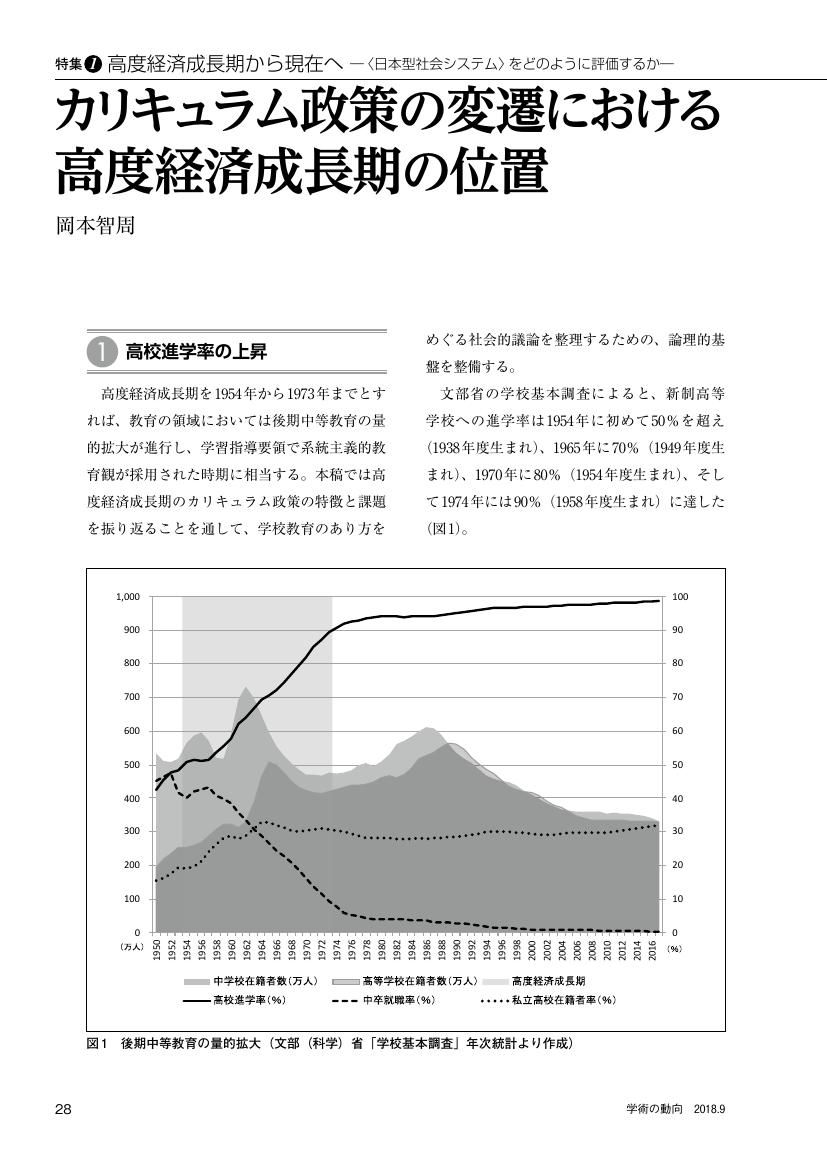10 0 0 0 OA 戦後日本の「サラリーマン」表象の変化
- 著者
- 岡本 智周 笹野 悦子
- 出版者
- The Japan Sociological Society
- 雑誌
- 社会学評論 (ISSN:00215414)
- 巻号頁・発行日
- vol.52, no.1, pp.16-32, 2001-06-30 (Released:2009-10-19)
- 参考文献数
- 28
- 被引用文献数
- 4 2
本稿は, 戦後の新聞紙上で「サラリーマン」の表象がいかに変化してきたのかを分析する.近年しばしば「サラリーマンと主婦に子ども」という家族構成が家族の「55年体制」と称されている.その「55年体制的サラリーマン」が戦後の全国紙において生成し, 消失していく過程を具体的に提示することが, 本稿の意義である.分析の対象は, 1945年から1999年の『朝日新聞』における, 見出しに「サラリーマン」という語が入った全1034件の記事である.我々はまずこれらの記事を量的に検討し, それらを内容の面から8つのカテゴリーに分け, さらにカテゴリーごとに「55年体制的サラリーマン」を自明視する記事の割合の増減を検討した.この作業によって戦後を5つの時期に区分することができた.次に我々は, 内容分析によって各時期の「サラリーマン」の特徴を提示した.「55年体制的サラリーマン」に関して明らかになったことは, その自明性が高度経済成長期の初期に初めて成立し, 「サラリーマン」に対して1960年代後半においては「納税」が, ポストオイルショック期においては「性別役割分業に基づいた家族への回帰」が期待されていたことである.また, その自明性がバブル経済期半ば以降に問い直され始め, 1990年代において「サラリーマン」にはリスクを伴う個人化傾向・周縁化傾向が促されつつあるということも, 本研究によって確認された.
9 0 0 0 OA カリキュラム政策の変遷における高度経済成長期の位置
- 著者
- 岡本 智周
- 出版者
- 公益財団法人 日本学術協力財団
- 雑誌
- 学術の動向 (ISSN:13423363)
- 巻号頁・発行日
- vol.23, no.9, pp.9_28-9_33, 2018-09-01 (Released:2019-01-18)
- 参考文献数
- 13
5 0 0 0 OA 在米日系人強制収容に対する補償法の変遷
- 著者
- 岡本 智周
- 出版者
- The Japan Sociological Society
- 雑誌
- 社会学評論 (ISSN:00215414)
- 巻号頁・発行日
- vol.54, no.2, pp.144-158, 2003-09-30 (Released:2010-01-29)
- 参考文献数
- 35
本稿は, 第2次世界大戦後のアメリカ社会において人種・民族間の階層性が変化し, 国民概念が変動してきたことを, 大戦中の日系人強制収容に関する補償法の変遷を通じて論じる.具体的には, 1948年の日系人退去補償請求法と1988年の市民自由法の相違点に, 国民統合のために掲げられる理念の変化を跡付ける.また補償法その他の法令資料を精査している点で, 本稿は日系人研究に寄与するものである。分析の枠組みとしてはアントニー・スミスの国民論を参照し, それが想定するエスニー間の関係が大戦後のアメリカ社会でどの程度維持されているのかを検討する.1948年法から1988年法への変遷からは, まず1948年法が, エスニー間の相容れなさと周辺的エスニーの劣位という点において, スミスが想定する国民の階層的構成原理を体現していることを把握することができる.しかし1960~70年代の社会変革を経験した後の1988年法では, 周辺的エスニーの記憶や経験を国民全体のそれへと組み入れるための制度が準備され, さらに周辺的エスニーと国民社会の中心との間の階層的関係の解消も試みられている.この変化は国民概念の根拠が普遍性を高めるプロセスであり, さらに1990年代には補償対象がナショナリティの範囲を越えて設定される点に, 概念の変動の副次的効果を指摘できる.アメリカの国民概念が原初主義的傾向を希薄にしていったとするのが, 本稿の結論である.
3 0 0 0 戦後日本の「サラリーマン」表象の変化:『朝日新聞』を事例に
- 著者
- 岡本 智周 笹野 悦子
- 出版者
- 日本社会学会
- 雑誌
- 社会学評論 (ISSN:00215414)
- 巻号頁・発行日
- vol.52, no.1, pp.16-32, 2001-06-30
- 被引用文献数
- 1 2
本稿は, 戦後の新聞紙上で「サラリーマン」の表象がいかに変化してきたのかを分析する.近年しばしば「サラリーマンと主婦に子ども」という家族構成が家族の「55年体制」と称されている.その「55年体制的サラリーマン」が戦後の全国紙において生成し, 消失していく過程を具体的に提示することが, 本稿の意義である.<BR>分析の対象は, 1945年から1999年の『朝日新聞』における, 見出しに「サラリーマン」という語が入った全1034件の記事である.我々はまずこれらの記事を量的に検討し, それらを内容の面から8つのカテゴリーに分け, さらにカテゴリーごとに「55年体制的サラリーマン」を自明視する記事の割合の増減を検討した.この作業によって戦後を5つの時期に区分することができた.<BR>次に我々は, 内容分析によって各時期の「サラリーマン」の特徴を提示した.「55年体制的サラリーマン」に関して明らかになったことは, その自明性が高度経済成長期の初期に初めて成立し, 「サラリーマン」に対して1960年代後半においては「納税」が, ポストオイルショック期においては「性別役割分業に基づいた家族への回帰」が期待されていたことである.また, その自明性がバブル経済期半ば以降に問い直され始め, 1990年代において「サラリーマン」にはリスクを伴う個人化傾向・周縁化傾向が促されつつあるということも, 本研究によって確認された.
1 0 0 0 OA 日系合衆国民のアメリカンアイデンティティ 西海岸とハワイの場合
- 著者
- 岡本 智周
- 出版者
- 社会学研究会
- 雑誌
- ソシオロジ (ISSN:05841380)
- 巻号頁・発行日
- vol.49, no.1, pp.3-19,190, 2004-05-31 (Released:2016-05-25)
- 参考文献数
- 25
This paper presents the current identity status of U.S. citizens of Japanese ancestry living on the West Coast and in Hawaii, and focuses on the way in which members of the younger generation connect "being a minority" with "being an American." In doing so, this paper examines the relationship between the empowerment of ethnic minorities and the conservative tendencies of American society. Neoconservatives claim that racial discrimination and racial equality should be considered only on the level of the individual, not on the level of ethnic groups. In the "color blind" United States of the twenty-first century, this logic can be adopted even by minority groups that have obtained some social power. This paper reviews previous studies about Japanese Americans' identities, and shows the result of the author's own research on the contemporary conditions of U.S. citizens of Japanese ancestry. Japanese Americans on the West Coast and Hawaii share the following two characteristics. First, among people of Japanese ancestry, those of the younger generation assert the priority of their American identity. They evoke their Japanese ethnicity secondarily in order to claim their uniqueness and to promote the diversity of the American nation. Second, the separateness of the Japanese ethnic group is disappearing. As seen in the examples of Japanese American Citizens League and Japanese American National Museum, the goals and the membership of the organizations are no longer exclusively and specifically Japanese. This paper therefore concludes that the democratization of national unification in the U.S. has proceeded in conjunction with not only the risk of populism in connection with overwhelming individualization, but also with the possibility of hybrid identities.
- 著者
- 岡本 智周
- 出版者
- 日本教育社会学会
- 雑誌
- 教育社会学研究 (ISSN:03873145)
- 巻号頁・発行日
- vol.68, pp.127-146, 2001-05-25 (Released:2011-03-18)
- 参考文献数
- 28
- 被引用文献数
- 1 1
This paper examines how the image of Japanese Americans has changedin U. S. history textbooks published in the second half of the 20th century.The main contribution of this study is to clarify when and why informationon Japanese Americans as a minority group became included in thedefinition of the “American nation” that had been taught as the basis ofnational integration. Through this examination, this study argues thatthe multiculturalization of education transforms the logic for socialintegration in the host society.The method of this study is the “storyline analysis, ” and the objectsof analyses are eighty history textbooks, study aids, and workbookspublished in the United States from 1952 to 1999. The findings can besummarized into the following three points:(1) Japanese American Studieswere already in full stride before 1988, when U.S. Congress gave a formalapology for the compulsory internment and enacted the Civil LibertiesAct;(2) depictions of people of Japanese descent found their place inAmerican historiography by being included into nationalistic educationalcontents in the 1980s; however, (3) in the 1990s, depictions of Japanese Americans came to reflect the change in U.S. national education, whichstarted attaching more importance to the universally acknowledged rightsof human beings.This study concludes that the change in the images of Japanese Americans between the 1980s and 1990s demonstrates the straying of U.S. history education from old-fashioned nationalism. Although U. S. historyeducation still adopts the form of “national” education, it gives pictures of “ethnic” minorities from the viewpoint of “universal” human dignity.This historiography can be formed within a mixture of ethnic contexts, national contexts, and universal contexts. In this sense, it can be saidthat in the 1990s, the importance of the framework of “national” historywas relativized into the importance of other frames of historiography.
- 著者
- 岡本 智周
- 出版者
- 筑波大学大学院人間総合科学研究科ヒューマン・ケア科学専攻共生教育学分野
- 雑誌
- 共生教育学研究
- 巻号頁・発行日
- vol.4, pp.101-111, 2010-03-31
1 0 0 0 OA <わたしの提言>共生教育学が目指すこと
- 著者
- 岡本 智周
- 出版者
- 筑波大学
- 雑誌
- 筑波フォーラム (ISSN:03851850)
- 巻号頁・発行日
- no.74, pp.127-129, 2006-11
1 0 0 0 OA 文化戦争以降の米国歴史教科書におけるジェンダー概念と社会統合の論理に関する研究
- 著者
- 岡本 智周
- 巻号頁・発行日
- 2010
課題番号:20730527
1 0 0 0 OA 歴史教育が採用する語り口の諸類型と教育の社会化機能に照らした効用に関する調査研究
- 著者
- 岡本 智周
- 巻号頁・発行日
- 2013
科学研究費助成事業(科学研究費補助金)研究成果報告書:基盤研究(C)2010-2012
- 著者
- 岡本 智周
- 出版者
- 筑波大学大学院人間総合科学研究科ヒューマン・ケア科学専攻共生教育学分野
- 雑誌
- 共生教育学研究
- 巻号頁・発行日
- vol.4, pp.101-111, 2010-03
1 0 0 0 OA 現代日本のリスク社会化環境における共生社会論のあり方と実践方法に関する実証的研究
後期近代社会としての日本社会は「リスク社会化」という社会構造の変動過程の文脈の中にあるが、こうした「リスク社会化」が生み出す社会環境のあり様にの下で「共生社会」という理念的枠組みを明らかにすることによって、「リスク社会」における「共生」問題の論理的構造を分析し、そのリスク回避へ向けての社会施策を考究するための理論の構築を目指した。この目的のために、初年度では従来の共生社会論の抱える問題点を摘出し、その理論的問題点を実証的に論じるための意識調査を二年度目に実行し、三年度目にそのデータ解析に基づく理論研究を行い、リスク社会における「共生」問題の理論的解明を行った。
